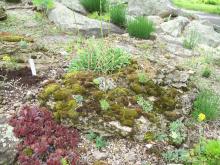I know that gardeners in Newfoundland and Norway can grow saxifrages readily, but I am getting tired of losing my favorites year after year. When I went through my garden and my file cards yesterday, I discovered I had three left in the ground--'Winnifred Bevington,' tucked against a piece of tufa on a slightly shaded north bank, 'Findling,' a mossy saxifrage, down low on that same bank, and 'Apple Blossom,' a pleasantly sprawly but totally non-blooming plant high on that same bank. Also, in a trough in a somewhat shady spot 'Correvon' and in a pot, 'Peter Pan.'
Other saxes that have lasted at least two years for me are oppositifolia, from seed, and my favorite, 'Faldonside'. These gradually shrunk, then disappeared. 'Winnifred Bevington' has become smaller too.
Saxifraga is one of my favorite genuses and I want to continue trying them, but don't want to throw good money after bad. Should I just plant them in pots or troughs and forget about the garden, even in or against tufa?
Comments
Re: saxifragas I can grow in Connecticut
Correction: the saxifraga in the trough is 'Correvoniana,' not Correvon. Also the non-blooming 'Apple Blossom' SEEMS to have buds--will it finally bloom next spring--or earlier?
Re: saxifragas I can grow in Connecticut
I can't tell you how you should grow them but I can however tell you how I grow them. (All pictures are taken today.)
The montane types that prefere much light I grow on the shed roof in a gritty soil mixed with peat and pieces of rock.
The shade loving ones I grow in my woodland often on moist soil but not with stagnant water. They even grow directly on a rock with no soil (right picture).
If your problems are tied to to warm and humid climate I have no experience with that ;)
Re: saxifragas I can grow in Connecticut
If your problems are tied to to warm and humid climate I have no experience with that ;)
Not much of that here either, Trond! Your plantings are really beautiful - I love how the various foliages have formed a tapestry of texture.
I don't have any particular insight on this myself, but I thought I'd remind readers of Stephanie Ferguson's article in the latest Rock Garden Quarterly. She says, "Saxifrages reward proper siting like no other plant" and goes on to explain how the aspect of alpine beds in one's yard can be used to optimally suit the needs of various saxifrages and other choice alpines. I would imagine that the basic principles behind her observations and advice would be generally useful in hotter and more humid climates too?
Malcolm McGregor also provides excellent information and advice on the siting of saxifrages in the garden (and also how they occur in nature) in his Saxifrages - an excellent read if you have access to the book, and perhaps some thoughts could be gleaned from it that would be also be helpful for those in hot, humid areas?
Re: saxifragas I can grow in Connecticut
I'm in Massachusetts, so my climate is quite similar to Barbara's and Rick's. A bit cooler than the former, and a bit warmer than the latter. But in July and August, it is quite the same, hot and humid for weeks. I grow a lot of saxes, and have been growing them successful for quite a few years. Whether or not I'm following any 'rules,' I seem to have figured out how to do it with success.
1. Don't plant saxes in the ground, other than a few particularly easy ones like S. paniculata and one really difficult one, S. oppositifolia. The latter is planted in a shady and cool area in pure sand and gravel, and it's been slowly increasing and blooming for 3 years.
2. Every other sax is planted IN tufa. Not next to it, not between two pieces, but IN it. I drill in the early fall and put in rooted cuttings, back-fill with tufa dust and sand, water in thoroughly, and then make sure that each planting gets watered every day until winter comes. In the spring, before the trees have leafed out, my tufa bed gets a lot of sun, but since I've positioned the tufa so that the saxes only get east and west exposures the rest of the spring, summer and early fall, they stay relatively cool and have been flourishing. I have my office overlooking the tufa bed, so I try to water it as often as possible, sometimes two or three times a day on hot, dry days and once a day during the mugs. I have a well, so the water is cold, and I water in the morning, with the sun giving them the early warning period. I also add very dilute fertilizer for at least the first two months, and stop at the end of June.
Today I've got at least 20 different saxes, and I just don't lose any once they've 'taken' in the tufa. My tufa is protected from midday sun by a giant sugar maple during most of the summer, so it gets sun early and late, and quite a nice moss covering has grown over the years, which seems to really help the saxes. The moss retains moisture, and protects the roots from the hottest weather. And each year I find a few self sown seedlings, that result from seed that has fallen 'into' the moss.
Re: saxifragas I can grow in Connecticut
I often here that tufa is great for growing alpines. However, no one ever explains why tufa is such a great growing medium. Can someone explain why things will grow on tufa when they won't grow in adjacent soil?
James
Re: saxifragas I can grow in Connecticut
I suppose it's the excellent drainage, with no chance of standing water to cause rot, and the lean, hard conditions that promote tight growth... that's my take on it, anyway. It seems a good facsimile for natural conditions for a species that might grow in a tight fracture, with the most minimal soil.
I was pleasantly surprised this summer at how well pot-grown saxifrages took to having their roots more-or-less exposed, and crammed into holes drilled into tufa - all have been looking very well all season.
Re: saxifragas I can grow in Connecticut
If your problems are tied to to warm and humid climate I have no experience with that ;)
Not much of that here either, Trond! Your plantings are really beautiful - I love how the various foliages have formed a tapestry of texture.
Thanks Lori - that is exactly what I aim to achieve - but the moss is natural although I do plant moss too!
Re: saxifragas I can grow in Connecticut
I always thought the benefit of tufa was that it helped keep alpine plants cool. Tufa is full of air. This makes it a good insulator, helping prevent the transfer of heat. Even when the tufa is hot, it will not transfer heat to a plant like solid stone or dark soil. Think of the difference between touching foam board and asphalt during summer. Even though these materials are the same temperature, asphalt transfers heat faster and 'feels' much hotter.
The plant evaporates water during photosynthesis. This helps cool the plant. Tufa's low heat transfer rate allows the plant to stay cooler than the ambient temperature. This can be the difference between survival or certain death for heat sensitive plants.
James
Re: saxifragas I can grow in Connecticut
What you say is true, but I suspect the major issue is the fact that during hot and humid weather, soil is a perfect environment for all kinds of pathogens, many of which are death to many higher altitude plants. Tufa doesn't have soil, or perhaps I could that it ISN'T soil, so these pathogens don't proliferate, and the plants remain healthy.
Re: saxifragas I can grow in Connecticut
Doesn't tufa also hold moisture, compared to other rocks like granite? I would think this would also be a factor.
Re: saxifragas I can grow in Connecticut
For those who do not have access to tufa you could try growing Saxes in a mix without any soil to avoid the problems with pathogens that Peter talks about. Our Saxes that are not in tufa are growing in granite rock crevices with a mix of sharp sand and crusher fines (the residue from rock crushing). Fortunately such a mix is readily available locally in British Columbia as it is used by landscapers underneath pavers. For rock garden use it provides good drainage, has no pathogens and contains mineral nutrients from the crushed rock particles that Saxes seem to like.
Despite our summers being cooler than Connecticut, Saxes prefer being planted in our garden on north facing slopes with some shade provided by rocks. Saxifraga oppositifolia needs even more shade in our garden to grow well and needs to be planted on north facing cliffs with very little direct sun, even in mid summer.
Re: saxifragas I can grow in Connecticut
I often grow plants in pots the first year or two. This allows me to move them around if they get stressed. I can determine how much sun they can tolerate. I often have to move plants completely out of the hot summer sun to the North side of my home.
Certain plants in my area only grow on the North face of ravines that receives almost no direct sunlight. Others are limited to cold air slopes or areas where cold water is dripping over a cliff face. These same plants grow in full sunlight farther North or at higher altitudes.
Correctly choosing aspect is very important. Variations in incident sunlight on different sides of a home give the opportunity to grow a much wider range of plants.
I have also had problems with pathogens. I solve this problem by growing many plants from seed and letting the fittest survive. However, choosing an appropriate soil type that prevents disease is the best cure.
Unfortunately, growing lots of seedlings is not an option if you desire a specific cultivar. I have lost many plants of expensive cultivars. Ironically, one plant of a cultivar may die while another plant right next to it thrives. I can only attribute this to pure chance.
Re: saxifragas I can grow in Connecticut
Thanks, everyone. Peter George seems to have the climate nearest to mine, so I'll try planting saxes in tufa from now on. I wish I had bought some more tufa from that truck at Lyndhurst Museum last week!
By the way I have been a member of the Forum for over two years. What do I have to do to stop being a Newbie? I am actually an Oldie!
Re: saxifragas I can grow in Connecticut
By the way I have been a member of the Forum for over two years. What do I have to do to stop being a Newbie? I am actually an Oldie!
Hi Barbara, I can explain. What you're seeing here is default behavior of the Forum software, where it names groups of users based upon how many posts they've added. The attached "inside look" at the SMF Administrative console shows the groups and the increments between each group. This is arbitrary "default" behavior right out of the box so to speak. The names and levels are customizeable; maybe we need a group for "Oldie but a Goodie" ;)
And just to make this post relevant to Saxifrages in Connecticut (or at least New England), click this link to see my pale pink Saxifrage fortunei which has been blooming for weeks, and is still in flower now :D
http://nargs.org/smf/index.php?topic=593.msg11488#msg11488
Re: saxifragas I can grow in Connecticut
Our Saxes that are not in tufa are growing in granite rock crevices with a mix of sharp sand and crusher fines (the residue from rock crushing).
Gee, and not thinking about it, I always just threw out the crushed fines that settle out in a bag of chick grit...
----------------------------------------
Barbara, the newbie designation has nothing to do with your time here at the Forum (or your age ;D). It changes with the number of postings you make. It goes something like:
1-49 posts = Newbie
50-99 = Junior member
100-? Full member
etc.
Re: saxifragas I can grow in Connecticut
I live in New York and am 20 minutes from Danbury, CT. I have had mixed results during my first year growing saxes. The silver and kabschias grown in tufa and in hypertufa troughs have done pretty well. The ones planted in the rock garden or in the soil have not done well. Some of the silvers had their roots eaten. The saxes purchased from Wrightman Alpines (get the $15 plants that are grown in mini tufa rocks) have done well. The alpen rocks they sell consist of three plants planted in a nice sized piece of tufa. So I have had mixed results and have lost about 20 plants grown outside of tufa or a trough. I have considered the loss of the plants "tuition" towards learning how to grow a tough species in a non-alpine environment. Mossies have not done well in NY.
McGregor's 2008 Saxifrage book is an excellent resource.




I'll be interested in better advice, too. I grow a few saxifrages, only in pots in troughs because I have no, even mildly, amenable in-ground areas for saxes. With the exception of S. crustata, excessive heat is always my main battle. Admittedly, I am sometimes neglectful in moving them to complete shade at these times. We do get extremely humid summer days, but not as many as you, Barbara.